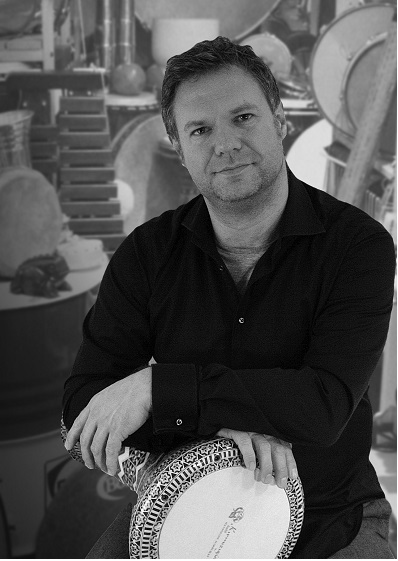

Speaker Christopher Fellinger
Natural Rhythmic Flow – The body and mind in space and time, as seen from the standpoint of a percussionist. (Theory and practice)

Christopher Fellinger
Christopher Fellinger, percussionist, lives and works in Munich. He studied drums at the Hermann Zilcher Conversatory in Würzburg and at the Drummer’s Focus in Munich. Since 2001 he teaches at the Rhabanus-Maurus-Gymnasium in St. Ottilien, Carl-Spitzweg-Gymnasium in Germering, as well as for the Musikverein Türkenfeld. Currently he has 50 students from age 5 to 50 years. He was a member of the juggler formation “Firlefanz” and founder of the “Force de-Frappe-Progressive Percussion Project”. As a composer and arranger, he mainly writes percussion and theater music. In addition to the “Index 4 Percussion Quartett” and the “Tollhaus Theater Compagnie,” he still participates in various orchestras and ensembles. He designs and conducts percussion workshops, and he is also the initiator of several youth percussion ensembles. Currently he is coaching five. The best-known of the ensembles, Hexagon-Percussion, has been performing for more than ten years successfully in sold-out concert halls. In 2016, the young musicians were nominated for the Tassilo Prize of the Süddeutsche Zeitung.
Mr. Fellinger, when did you get to know Matrix Rhythm Therapy and what are your experiences?
I got to know Matrix Rhythm Therapy in 2010 and have had very good experiences with it. Very common problems musicians have are cervical vertebra problems. I already have slipped two discs, which put pressure against each other. Percussionists will then typically experience cramping and tension in the back. When treated with Matrix Rhythm Therapy, it vibrates my body-mind back to zero. That’s what it feels like, which I like very much. I should do that a lot more often.
The tension of many musicians, however, also has to do mostly with stress and pressure. For example, the pressure of playing in an orchestra is enormous. When you are a professional and get an assignment in an orchester you just have one and a half rehearsals before the concerts starts. There is no room for mistakes, if you want to get another engagement. Of course, the stress is even higher for soloists. There are hundreds of people sitting in the hall, who have paid admission, and now, it is time to deliver!
The speech at the congress is called “Natural Rhythmic Flow”. What is Natural Rhythmic Flow and what are the parallels to Matrix Rhythm Therapy?
Take the drumming for example. It does not depend on the drumbeat, but on the way your body moves through space. If you are not relaxed, thus moving unnaturally, then the result will sound artificial. Nobody can build a natural rhythm out of empty space. It is quite different. If I move in space, my body and mind being relaxed, then it develops a natural rhythm according to natural laws. Movement in space and time is interdependent. This is how rhythm develops.
Every week I have 50 students and 5 ensembles. Everyone is different, physically as well as mentally. It is very interesting to see how different the individual people are. For some people, these rhythmic laws are immediately there, and some have to get back on track. Here, it is clearly parallel to Matrix Rhythm Therapy: to get something back in motion and to achieve permeability for body and mind.
Can you give us more examples of how natural rhythm is determined by movement, space and time?
As a juror of the Bavarian Musicians Association and “Jugend musiziert,” I always hear the same pieces that are played by different people. This is a study to observe here how the individual musicians move around the room, how they feel, and above all, how differently the same piece sounds. Sometimes I experience in competitions or in the classroom a 5year old, who plays so well that you hold your breath in awe. It is pure space, pure time, and pure energy. On the other hand, an older person who has been playing for a long time, who can have enormous difficulties gaining such access. This approach has to do with vagus, or parasympathetic versus sympathetic. The 5-year-old is so relaxed, so much in the vagus, he does not even realize it. There are others for that – and unfortunately this is the common European conception of music, or rather, how music is educated here – caught in its ratio, in the sympathetic. The focus is on the notes – not the physicality. And you hear that right away.
And I still see a connection to the participants of the Matrix Congress. Sometimes I feel more like a personal trainer or therapist than a music teacher. I experience again and again what the difficulties are. I also have hyperactive children, dyslexics, and some have right-left coordination difficulties. While drumming, the kids have to synchronize space, movement and time in order. Each week this is what drumming is about, it is about the big reset. And this is a very good experience for the children. Their find order within their minds.
How does this synchronization come about?
One of the key phrases of my own education was “We are not playing Musical Chairs.” Every stroke has its place in advance. The seats are there. You just have to make them visible. There is no hurry or delay required. Even with a quick piece, you should not hurry or strain. Here only the distribution of the blows is a bit denser. It’s essentially about being in the here and now.
I often tell my students to wake up— we’re not at school here! It’s not about performance. Doing is not worth anything when it is exhausting – and what is the magic word in drums? The magic word is: slow.
Some, who are in the fast lane, sometimes still do not know what they’re doing after 20 reps. Only when you are slow can you feel and recognize the space and the order. The mind has the chance to catch everything. This order is the feedback to yourself. After the second time slowly, you have mostly cleaned up and put it in order, and then, you have the “aha” experience.
For example, some cannot play with a metronome at a click. This has nothing to do with aptitude. They are either before or after the click, mostly they are before that. Because their head is usually earlier. Always the same in want – just as our society is ticking.
I really enjoy seeing it understood and lived, which I try to share. I often accompany students over ten years or more. The impact this flow has on the lives of students, the feedback I get from students and their parents, is a great pleasure to me.
Your lecture is called Natural Rhythmic Flow in theory and practice. Does that mean that you also do a practical part with the participants?
Yes, I will do body-percussion with the participants. Here we can practically experience what rhythm is and why movement, space and time are so important.
And I will demonstrate a few examples so that the participants can experience and hear for themselves, what makes a good-sounding rhythm, and how your body sensation reacts to it. A drummer not only has the drums on which he drums, and the sticks he has in his hand, but his body is also part of the instrument.
Contact:
Publications: Mostly published by C. Alan Publications

